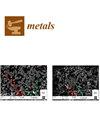Comparison on Hysteresis Loops and Dislocation Configurations in Fatigued Face-Centered Cubic Single Crystals
IF 2.5
3区 材料科学
Q3 MATERIALS SCIENCE, MULTIDISCIPLINARY
引用次数: 0
Abstract
The aggregation and evolution of dislocations form different configurations, which are the preferred locations for fatigue crack initiation. To analyze the spatial distribution of the same dislocation configuration and the resulting configuration morphologies on different observation planes, several typical hysteresis loops and dislocation configurations in fatigued face-centered cubic single crystals with various orientations were compared. The crystal orientations of these specimens were determined by the electron back-scattering diffraction technique in a Cambridge S360 Scanning Electron Microscope. It is well known that dislocation ladder and wall structures, as well as patch and vein structures, are distributed on their respective observation planes, (12¯1) and (111). These correspond to the point defect direction and line defect direction of dislocations, respectively. Therefore, the wall structures on the (12¯1) and (111) planes consist of point defects and line defects, which can be defined as point walls and line walls, respectively. Furthermore, the walls on the (12¯1) plane consist of Persistent Slip Band ladders connected with each other, corresponding to the formation of deformation bands. The evolution of dislocation patterns follows a process from patch to ladder and from vein to wall. The formation of labyrinths and dislocation cells originates from the activation of different secondary slip systems. In one word, it can help us better understand the physical nature of metal fatigue and failure by studying the distribution and evolution of different configurations.疲劳面心立方单晶中的磁滞环和位错配置比较
位错的聚集和演变形成了不同的构型,这些构型是疲劳裂纹萌发的首选位置。为了分析同一位错构型在不同观察平面上的空间分布和由此产生的构型形态,我们比较了疲劳面心立方单晶中不同取向的几种典型滞后环和位错构型。这些试样的晶体取向是通过剑桥 S360 扫描电子显微镜中的电子反向散射衍射技术确定的。众所周知,位错阶梯结构和壁结构以及斑块结构和脉络结构都分布在各自的观察平面上,即 (12¯1) 和 (111)。它们分别对应于位错的点缺陷方向和线缺陷方向。因此,(12¯1) 和 (111) 平面上的壁结构由点缺陷和线缺陷组成,可分别定义为点壁和线壁。此外,(12¯1)面上的壁由相互连接的持久滑移带梯级组成,对应于变形带的形成。位错模式的演化过程是由斑块到阶梯,再由脉络到壁的过程。迷宫和位错单元的形成源于不同次级滑移系统的激活。总之,通过研究不同构型的分布和演变,可以帮助我们更好地理解金属疲劳和失效的物理本质。
本文章由计算机程序翻译,如有差异,请以英文原文为准。
求助全文
约1分钟内获得全文
求助全文
来源期刊

Metals
MATERIALS SCIENCE, MULTIDISCIPLINARY-METALLURGY & METALLURGICAL ENGINEERING
CiteScore
4.90
自引率
13.80%
发文量
1832
审稿时长
1.5 months
期刊介绍:
Metals (ISSN 2075-4701) is an open access journal of related scientific research and technology development. It publishes reviews, regular research papers (articles) and short communications. Our aim is to encourage scientists to publish their experimental and theoretical results in as much detail as possible. Therefore, there is no restriction on the length of the papers. The full experimental details must be provided so that the results can be reproduced. Metals provides a forum for publishing papers which advance the in-depth understanding of the relationship between the structure, the properties or the functions of all kinds of metals.
 求助内容:
求助内容: 应助结果提醒方式:
应助结果提醒方式:


